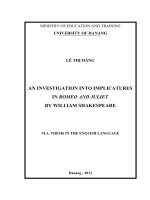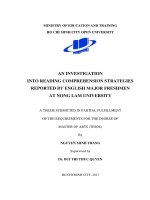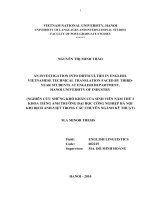AN INVESTIGATION INTO APPRECIATION IN “PERFECT SPY” BY LARRY BERMAN AND ITS VIETNAMESE VERSION “điệp VIÊN HOÀN hảo” BY đỗ HÙNG IN PERSPECTIVES OF APPRAISAL THEORY AND FUNCTIONAL GRAMMAR
Bạn đang xem bản rút gọn của tài liệu. Xem và tải ngay bản đầy đủ của tài liệu tại đây (318.91 KB, 32 trang )
MINISTRY OF EDUCATION AND TRAINING
THE UNIVERSITY OF DANANG
NGUYỄN THỊ THÚY PHƯỢNG
AN INVESTIGATION INTO APPRECIATION IN
“PERFECT SPY” BY LARRY BERMAN AND ITS
VIETNAMESE VERSION “ĐIỆP VIÊN HOÀN HẢO” BY
ĐỖ HÙNG IN PERSPECTIVES OF APPRAISAL
THEORY AND FUNCTIONAL GRAMMAR
Field: The English language
Code: 60.22.02.01
MASTER THESIS IN SOCIAL
SCIENCES AND HUMANITIES
(Summary)
Da Nang, 2015
The study has been completed at The University of Foreign
Language Studies, The University of Danang
Supervisor: Ngũ Thiện Hùng, Ph.D
Examiner 1: PGS.TS. Trương Viên
Examiner 2: TS. Trần Quang Hải
The thesis will be orally defended at The Examining
Committee.
Field: The English language
Time: August 15th- 16th
Venue: The University of Danang
The thesis is accessible for the purpose of reference at:
- Information Resource Center, The University of Danang
- The Library of University of Foreign Language Studies,
The University of Danang
1
CHAPTER 1
INTRODUCTION
1.1. RATIONALE
There is no denying that books on America’s war in
Vietnam have great influence on not only Vietnamese people
but almost everyone around the world as well. The writers aim
to set up solidarity and connection with potential or target
readers through crucial functions of language. By means of
language of evaluation appreciation in view of theory of
Appraisal framework and Functional Grammar, the writers’
messages are conveyed to readers more persuasively and
impressively.
In stories, the language of appreciation is indicated via
diversified lexical items and semantic patterns. The language in
stories, especially in war stories is full of emotion and
admiration towards soldiers or spies, civilians, events, battle
scenes…
Over the last few years, many studies on appreciation and
interaction have been carried out by scholars and linguists, but
they primarily centered on only one subcategory of the
Appraisal subsystems nevertheless. Even a deep research hasn’t
been studied to analyze the Appreciation language in a story of
strategic spies. For that reason, I would like to carry out a
fascinating research on “An investigation into Appreciation in
“Perfect Spy” by Larry Berman and its Vietnamese version
“Điệp Viên Hoàn Hảo” by Đỗ Hùng in perspectives of
Appraisal Theory and Functional Grammar” as the topic of
my thesis. It is hoped that readers will comprehend the methods
2
how writers show different tones of emotions.
3
1.2. AIMS OF THE STUDY
The study aims at investigating and discovering the possible
language realizations of appreciation in the novel and its
translational version. Also, the study is aimed at finding the
differences and similarities in the language of expressing
emotions between Vietnamese and English through the novel.
What’s more, the study’s findings contribute to the better
understanding of Appreciation expressions, which facilitates the
translation of emotional language from English to Vietnamese
and vice versa.
1.3. OBJECTIVES OF THE STUDY
With the aforementioned aims, the study attempts to achieve
the following objectives:
- To identify types and different realizations of Appreciation
in the novel and its Vietnamese version in view of Functional
Grammar.
- To compare and contrast the Appreciation-language used in
the novel and how it was translated into Vietnamese to clarify
the similarities and differences in expressing Appreciation
between English and Vietnamese.
- To put forward some implications of the findings for the
teaching and learning of translation, especially for the
translation of appraisal expressions.
1.4. RESEARCH QUESTIONS
1. What are the syntactic and semantic features of the
appreciation in “Perfect Spy” in English and Vietnamese?
4
2. What are the similarities and differences of appreciation in
“Perfect Spy” in English and Vietnamese in terms of syntactic
and semantic features in view of Functional Grammar?
1.5. SCOPE OF THE STUDY
The study focuses only on the semantic aspects as well as the
characteristics of Appraisal language in the story in English and
its translational equivalent. Semantic aspects as well as the
syntax will be examined in view of Appraisal Theory and
Functional Grammar where the syntactic realizations within the
scope of clause of message and clause of exchange are
identified.
1.6. THE SIGNIFICANCE OF THE STUDY
This investigation attempts to clarify the similarities and
differences of appreciation in “Perfect Spy” in English and
Vietnamese in terms of syntactic and semantic features in view
of Functional Grammar with the hope that it will help English
learners and teachers translate short stories into English vice
versa with the resources available within the evaluative language
in Appraisal theory. Hopefully, the findings of the study can be
a necessary source for suggesting some good implications for
teaching and learning translation skill better. The contrastive
information will be used to facilitate the translation of emotional
language from English to Vietnamese and vice versa concerning
the use of appreciation in portraying the characters in a story or
novel.
1.7. ORGANIZATION OF THE STUDY
The research includes five chapters.
5
Chapter 1 is Introduction. Chapter 2 is Literature Review and
Theoretical Background. Chapter 3 is Methods and Procedures.
Chapter 4 is Findings and Discussions. Chapter 5 is Conclusion,
Implications and Suggestions for further research beyond the
limits of the study.
6
CHAPTER 2
LITERATURE REVIEW AND
THEORETICAL BACKGROUND
2.1. REVIEW OF PREVIOUS STUDIES
Appreciation, in the Martin's Appraisal theory (2000), can be
thought of as the system by which human feelings, either
positive or negative, towards products, processes and entities are
institutionalized as a set of evaluations. The system is organized
in three subcategories: reaction with impact and quality
meaning, composition with balance and complexity meaning
and valuation meaning.
Martin & Rose (2003) (2005), Whitelaw, Garag and
Argamon (2005), Whitelaw et al. (2005), Fletcher and Patrick
(2005), Neviarouskaya et al. (2010), Izard’s (1971), Read and
Caroll (2010) express interesting views in their research, they
gathered that use of features based on appraisal group analysis
can significantly improve sentiment classification.
In Vietnam, Hồ Lộng Ngọc (2006) examined and described
the disclaim markers in English and Vietnamese in view of
Appraisal. The study investigated a wide range of linguistic
devices to mark the speakers / writers’ disclaim with different
structures of verbs, adverbs, adjectives and nouns in the two
languages.
Nguyễn Văn Khôi (2006) mentioned about Proclaim markers
in English and Vietnamese drawn on Appraisal theory. The
syntactic, semantic and pragmatic features of proclaim markers
in epistemic modality and evidentiality, speech acts, force
7
dynamics, politeness principles, and dialogistic view were
exploited in the study.
Huỳnh Thị Hoài Trang (2014) investigated subjectivity and
objectivity of English and Vietnamese editorials based on two
branches of Appraisal theory, Attitude and Engagement. The
study exploited syntactic, semantic and pragmatic features in
two languages to prove similarities and differences between
them.
The previous studies mentioned about some categories under
the Appraisal framework found out how to use them effectively.
Nevertheless, the linguistic features of appreciation in “Perfect
Spy” in English and Vietnamese in detail have not been
investigated up to now. Accordingly, it is hoped that this
investigation will be a contribution to provide Vietnamese
learners of English a better insight into the usage of appreciation
in English language teaching and translating stories into
Vietnamese and vice versa.
2.2 THEORETICAL BACKGROUND
2.2.1. An overview of Systemic Functional Grammar
Halliday and Matthiessen (2004) states Systemic Functional
Grammar attempts to construe and describe the organization of
the ‘meaning-making resources’. Halliday analyzed the
functions of language into three broad meta-functions:
ideational, interpersonal and textual. Each of the three
metafunctions is about a different aspect of the world, and is
concerned with a different mode of meaning of clauses, namely,
clauses as representations, clauses as exchanges, clauses
as messages.
8
a. Clause of exchange: Interpersonal metafunction
A clause is analyzed into MOOD and RESIDUE:
- The MOOD: Subject and Finite
+ The Subject: nominal groups
+ The Finite: the tensed element of the verb
- The RESIDUE: Predicator, Complement, and Adjunct
+ The Predicator: the non-tensed (or nonfinite) element or
elements of the verbal group
+ The Complement: nominal groups
+ The Adjunct: an adverbial group or prepositional phrase
As an exchange, the MOOD of a clause can be identified
from its grammatical structure: declarative mood (statement),
interrogative mood (question), imperative mood (command).
b. Clause as Message: Textual metafunction
According to Halliday (2004), clause as message is stated a
clause which has meaning as a message, a quantum of
information. In the clause as a message, there are theme and
rheme.
Theme is the first constituent that is either participant,
circumstance, or process of a clause. Rheme is the remainder of
the message, the part where the Theme is developed. A message
structure in English is comprised of a Theme plus a Rheme.
In many instances Rheme is related to New Information,
while Theme is related to Given Information.
c. Nominal Group
Halliday (2004) states that in terms of the modal structure of
the clause, nominal groups serve as Subject or Complement,
verbal groups as Finite + Predicator, and adverbial groups as
9
Adjunct; and in terms of the experiential structure, nominal
groups serve in participant roles, verbal groups as Process, and
adverbial groups in circumstance roles.
2.2.2. Appraisal Theory
Martin and White (2005, p.95) finds that the Appraisal
framework sees declarations of attitude as “dialogically directed
towards aligning the addressee into a community of shared
values and belief”. There are three semantic areas of Appraisal
termed Attitude, Engagement, and Graduation.
a. Engagement
Martin & White (2005, p.97) defines that Engagement is
“directed towards identifying the particular dialogic positioning
associated with given meanings and towards describing what is
at stake when one meaning rather than another is employed”.
b. Graduation
Martin & White (2005, p.35) states that Graduation deals
with “grading phenomena whereby feelings are amplified and
categories blurred”. It is divided into two major resources:
Force and Focus.
c. Attitude
Martin & White (2005, p.35) confirms that attitude is
“concerned with our feelings, including emotional reactions,
judgements of behaviour and evaluation of things”. It embraces
three resources: Affect, Judgement and Appreciation. Affect
deals with resources for expressing emotional states and
responses; Judgement deals with resources for expressing
norms; Appreciation deals with resources for expressing tastes
aesthetic likes/dislikes.
10
2.2.3. Appreciation and related conceptions
Martin and White (2005, p.43) defines that appreciation can
be thought of as the system by which human feelings, either
positive or negative, towards products, processes and entities are
institutionalized as a set of evaluations. Appreciation shares
with judgement this property of being oriented towards the
'appraised' rather than the subjective 'appraiser'.
2.4. SUMMARY
CHAPTER 3
METHOD AND PROCEDURE
3.1. RESEARCH METHOD
This comparative study employed a mixed method approach
that involves descriptive, qualitative and quantitative and
contrastive techniques for data interpretation.
3.2. PROCEDURE OF THE STUDY
- Collecting appreciation from two works as much as
possible.
- Taking notes and identifying the chosen samples in terms of
syntactic and semantic dimensions.
- Picking out different types of appreciation in “Perfect Spy”
according to structural, semantic and functional characteristics.
- Analyzing and discussing the results in terms of syntactic
and semantic features.
Comparing instances of appreciation between English and
Vietnamese in “Perfect Spy” and its Vietnamese version in
terms of syntactic and semantic features.
11
Suggesting some implications in using appreciation for
language users from the similarities and differences in terms of
syntax and semantics of appreciative language.
3.3. SAMPLING AND POPULATION
3.3.1. Sampling of study
3.3.2. Population of Study
In the framework of the study, 100 English and 100
Vietnamese samples of appreciation were gathered and selected
from “Perfect Spy” by Larry Berman and its Vietnamese version
“Điệp viên hoàn hảo” by Đỗ Hùng to serve the analysis of the
linguistic features.
3.3.3. Instruments of Data Collection
3.4. DATA ANALYSIS
The instances of appreciation used in “Perfect Spy” by Larry
Berman and its Vietnamese version “Điệp viên hoàn hảo” by Đỗ
Hùng were analyzed to reveal the information about these
following aspects:
Syntactic features of appreciation such as clause, nominal
groups, adjectival group and verbal group in view of Functional
Grammar are examined in both works.
- Semantic features of appreciation with three subtypes:
reaction, composition and valuation that terms of appreciation of
feelings, thoughts, activities of the entities in the work “Perfect
Spy” and its Vietnamese version need analyzing in view of
appraisal theory.
Contrastive analysis of appreciation for variety of structures
such as the syntactic variants from adjectives, adverbs, verbs,
nouns of both works also need to be analyzed.
12
3.5. RELIABILITY AND VALIDITY
Two most important criteria to guarantee the quality of the
data collection procedures are reliability and validity.
3.6. SUMMARY
CHAPTER 4
FINDINGS AND DISCUSSION
4.1. SYNTACTIC FEATURES OF APPRECIATION IN
“PERFECT SPY” BY LARRY BERMAN AND ITS
VIETNAMESE VERSION “ĐIỆP VIÊN HOÀN HẢO” BY
ĐỖ HÙNG IN VIEW OF FUNCTIONAL GRAMMAR
4.1.1. Appreciation in “Perfect Spy” by Larry Berman
and its Vietnamese version “Điệp Viên Hoàn Hảo” by Đỗ
Hùng as Clause of Message and Exchange
We analyzed the appreciation in the two authors' works in
view of clause of message and exchange. The appreciation in
these works is organized in the embedded form of ThemeRheme and Mood-Residue. Theme is the part that starts from the
beginning of the clause. Rheme is the remainder of a message,
the part in which Theme is developed. A clause of message
embraces a theme and a rheme. Similarly, the Mood of a clause
contains the subject and the finite, which is realized by the
tensed element of the verb; the Residue consists of the
Predicator which is realized by the non-tensed (or nonfinite)
element or elements of the verbal group, the Complement, and
the Adjunct. However, the information isn't depicted in the form
of Mood and Residue in Vietnamese.
Table 4.1. Distribution of Sentence Types of Appreciation in the
13
Two Authors' Works in terms of Clause of message
As can be seen from the table 4.1, there is a tendency to use
complete simple sentences (with It) and compound sentences in
showing appreciation (20% in English and 21% in Vietnamese).
While complex sentences take up the highest rate in both works
(25% and 21%), the rate of compound-complex sentences
account for 15% in English and 16% in Vietnamese, the lowest
rate.
Table 4.2. Distribution of Sentence Types of Appreciation in the
Two Authors' Works in terms of Clause of exchange
It can be seen clearly from the table 4.2 that the proportion of
appreciation in English in terms of Clause of exchange
14
fluctuates from 15% to 25% while that of Vietnamese
appreciation fluctuates from 0% to 45%, suggesting that
appreciation in terms of Clause of exchange in English occurs
more frequently than that in Vietnamese. In particular,
appreciation in the form of complete simple sentences (with It /
Đó là) isn't completely used in Vietnamese despite the fact that
appreciation in the form of complex sentences takes up the
highest proportion with 45% in Vietnamese.
4.1.2. Appreciation in “Perfect Spy” by Larry Berman
and its Vietnamese version “Điệp Viên Hoàn Hảo” by Đỗ
Hùng as Nominal Group
Reading “Perfect Spy” by Larry Berman and its Vietnamese
version “Điệp Viên Hoàn Hảo” by Đỗ Hùng, we can confirm
that there is a variety of forms of appreciation. Besides various
kinds of sentences analysed in 4.1.1, we also take into account
experiential structures of a nominal group which are used to
make comments to the strategic spy Pham Xuan An, other war
correspondents or the bleeding war such as 'imminent death',
'perspicacious mind' in “Perfect Spy” by Larry Berman; 'điệp
viên đơn độc', 'cái xác khô' in “Điệp Viên Hoàn Hảo” by Đỗ
Hùng.
Table 4.3. Distribution of Appreciation in Experiential
Structures as Nominal Groups in the Two Authors' Works
15
The table 4.3 shows that there are some remarkable
differences in the distribution of appreciation in experiential
structures as Nominal Groups.
In five kinds, deictic + epithet + thing ranks first with 48% in
English and 46% in Vietnamese. Epithet + thing ranks second
but the rate of Vietnamese is 20%, which is 4% more than that
of English. Ranking third, deictic + epithet + classifier + thing
accounts for 11% in English but 15% in Vietnamese. The rate of
deictic + multiple epithet + thing is 13% while there is 11% in
Vietnamese, which ranks fourth. The last is epithet as verb
function shares the lowest level 11% in English and only 8% in
Vietnamese.
4.1.3. Summary
4.2. SEMANTIC FEATURES OF APPRECIATION IN
“PERFECT SPY” BY LARRY BERMAN AND ITS
VIETNAMESE VERSION “ĐIỆP VIÊN HOÀN HẢO” BY
ĐỖ HÙNG IN VIEW OF APPRAISAL
Understanding and analyzing semantic features of
appreciation in the work “Perfect Spy” and its Vietnamese
version “Điệp Viên Hoàn Hảo” is a crucial problem in this part.
16
It is advisable that the researcher focus on drawing a distinction
between the enemy's subjective evaluation and the authors'
appreciation accordingly.
Appreciation is the subsystem of resources for aesthetic
evaluation of objects, entities, presentation, etc. it has positive
and negative dimensions. Appreciation has three subtypes:
reaction, composition and valuation.
4.2.1. The reaction meaning of appreciation in “Perfect
Spy” and its Vietnamese version “Điệp Viên Hoàn Hảo”
a. Reaction: Impact
Table 4.4. Distribution of Reaction-Impact appreciation
meaning
Who
"PERFECT SPY"
"ĐIỆP VIÊN
appreciated
HOÀN HẢO"
?
(+
(+
Rate (-) Rate
Rate (-) Rate
)
)
25%
12.5
0.0
The author
2
1
4 57% 0
%
%
0.0%
25%
0.0
The enemy
0
2
0
1 14%
%
12.5
12.5
0.0
The others
1
1
0
2 29%
%
%
%
Pham Xuan
12.5
12.5
0.0
0.0
1
0
0
0
An
%
%
%
%
Total
4 50% 4 50% 4 57% 3 43%
Total
8 (100%)
7 (100%)
17
Table 4.5 clearly illustrates the Reaction-Impact appreciation
meaning is quite evenly distributed in both languages. However,
there is a growing tendency to evaluate by the authors higher
than any other people (57% in Vietnamese and 25% in English).
The others' appreciation ranks second with the proportion of
25% in English and 29% in Vietnamese. Ranking third with the
rate of 25% in English and 14% in Vietnamese belongs to the
enemy's appreciation. And the lowest is Mr An's (12.5%).
b. Reaction: Quality
Table 4.5. Distribution of Reaction-Quality appreciation
meaning
Who
"PERFECT SPY"
"ĐIỆP VIÊN
appreciated
HOÀN HẢO"
?
(+
(+
Rat
Rate (-) Rate
Rate (-)
)
)
e
The author
6 67% 3 33% 0
0% 0 0%
29
The enemy
0
0%
0
0%
3 42% 2
%
29
The others
0
0%
0
0%
0
0% 2
%
Pham Xuan
0
0%
0
0%
0
0% 0 0%
An
6 67% 3 33%
58
Total
3 42% 4
%
Total
9 (100%)
7 (100%)
18
We can see that the Reaction-Quality appreciation in English
is two more than that in Vietnamese. The rate of the author's
appreciation takes up 67%, the highest figure.
4.2.2. The composition meaning of appreciation in
“Perfect Spy” and its Vietnamese version “Điệp Viên
Hoàn Hảo”
a. Composition: Balance
Table 4.6. Distribution of Composition-Balance appreciation
meaning
Who
"PERFECT SPY"
"ĐIỆP VIÊN HOÀN
appreciated
HẢO"
?
(+
(+
Rate (-) Rate
Rate (-) Rate
)
)
The author
1 17% 1 17% 0
0% 3 50%
The enemy
0
0%
0
0%
0
0% 0
0%
The others
4 66% 0
0%
2 33% 0
0%
Pham Xuan
0
0%
0
0%
1 17% 0
0%
An
Total
5 83% 1 17% 3 50% 3 50%
Total
6 (100%)
6 (100%)
Although there is the same proportion of showing
appreciation in terms of Composition-Balance meaning in both
languages, the others' appreciation is carried out more frequently
with the rate of 66% in English and 33% in Vietnamese. This
means that not only the authors but also other correspondents
express their genuine admiration for the gifted intelligence spy
19
and the Vietnamese people's convincing victory over the antiAmerican resistance war in Vietnam.
b. Composition: Complexity
Table 4.7. Distribution of Composition-Balance appreciation
meaning
Who
"PERFECT SPY"
"ĐIỆP VIÊN HOÀN
appreciated
HẢO"
?
(+
(+
Rate (-) Rate
Rate (-) Rate
)
)
The author
3 43% 2 29% 1 17% 4 66%
The enemy
0
0%
0
0%
0
0% 0
0%
The others
1 14% 0
0%
0
0% 1 17%
Pham Xuan
0
0%
1 14% 0
0% 0
0%
An
Total
4 57% 3 43% 1 17% 5 83%
Total
7 (100%)
6 (100%)
Table 4.7 also demonstrates that the highest appreciation
(66% in Vietnamese and 43% in English) belongs to the author
and the enemy's appreciation has no percentage while Mr An
accounts for only 1% in English.
4.2.3. The valuation meaning of appreciation in “Perfect
Spy” and its Vietnamese version “Điệp Viên Hoàn Hảo”
Table 4.8. Distribution of Valuation appreciation meaning
Who
"PERFECT SPY"
"ĐIỆP VIÊN
appreciated
HOÀN HẢO"
?
20
(+
)
2
2
1
Rate
(-)
Rate
(+
)
5
2
0
Rate (-)
Rate
The author
20% 1 10%
45% 1 10%
The enemy
20% 2 20%
18% 3 27%
The others
10% 2 20%
0% 0
0%
Pham Xuan
0
0%
0
0%
0
0% 0
0%
An
Total
5 50% 5 50% 7 63% 4 37%
Total
10 (100%)
11 (100%)
It can be seen clearly from the table 4.13 that the same
proportion of appreciation of the author and the enemy (85%) is
that the author's takes up 30% in English and 55% in
Vietnamese and the enemy's occupies 40% in English and 45%
in Vietnamese. The lowest appreciation belongs to the others
with 30% in English and there is no appreciation in Vietnamese.
21
Table 4.9. Distribution of Semantic Feature of Appreciation in
the Two Authors' works
It can be seen from the chart that appreciation terms in view
of Appraisal in “Perfect Spy” by Larry Berman and its
Vietnamese version “Điệp Viên Hoàn Hảo” by Đỗ Hùng is quite
distributed evenly. For example, reaction takes the leading rate
in both of two works with 43% in English and 41% in
Vietnamese. Ranking second, composition has the same rate
with 31% in both languages. With the lowest rate, valuation
takes up 26% in English and 28% in Vietnamese.
Table 4.10. Distribution of Semantic Feature of Appreciation Subcategories in the Two Authors' works
22
Table 4.10 above shows that appreciation with valuation is
distributed the most frequently of five with 26% in English and
28% in Vietnamese. Appreciation with reaction-quality meaning
is the second order with 21% in English and 18% in
Vietnamese. Appreciation with reaction-impact meaning
account for 22% in English and 23% in Vietnamese, which
ranks third. Ranking third, there is a slight reduce in distributing
(17% in English and 15% in Vietnamese) while CompositionBalance occupies 14% in English and 16% in Vietnamese. And
the least frequently - appreciation with balance meaning and
appreciation with complexity meaning with 4% in English and
4% in Vietnamese.
4.2.4. Summary
4.3. SOME REMARKS FROM THE CONTRASTIVE
ANALYSIS OF APPRECIATION IN PERFECT SPY”
BY LARRY BERMAN AND ITS VIETNAMESE VERSION
“ĐIỆP VIÊN HOÀN HẢO” BY ĐỖ HÙNG: THE
SIMILARITIES AND DIFFERENCES
4.3.1. Similarities
Syntactically, both English and Vietnamese appreciation of
two works have some points of functional elements in common,
namely in the clause of message and nominal structure. Found in
various positions in the sentence such as initial position, medial
position and final position. Appreciation of two works has been
carried out seriously and it can be seen that both of English and
Vietnamese works have different expressions which are
accompanied by epithet, epithet with thing; deictic, epithet,
thing, or deictic, epithet, classifier and thing. All of them have
23
been particularly demonstrated via Functional Grammar. What's
more, appreciation has the same position and syntactic function
in the clausal structure or utterance in "Perfect Spy” and its
Vietnamese version.
Semantically, appreciation of two works shares the same
lexical items that contribute to the specific meaning of the
structure. Both English and Vietnamese appreciations contain
the detailed description of the semantic features and can be
divided into three types: reaction with impact and quality
meaning, composition with balance and complexity meaning,
and valuation meaning. These lexical items contain the
descriptive information in the war, correspondents and
especially a communist spy. The positive or negative, pleasant
or unpleasant, favorable or unfavorable aspects of the
information can also be seen as one of the components that
dominates writers’ choice of a specific appreciation in a
particular context. In addition, appreciation of two works could
be used to express writers’ intention, opinion, feeling with the
hope that information, opinions, comments on the war can
remind us of a legendary figure who made a major contribution
to national peace and independence.
4.3.2. Differences
On the contrary, we find a slight difference between English
meaning and its Vietnamese version. While in English,
appreciation consists of a variety of structures such as the
syntactic variants from adjectives, adverbs, verbs, nouns,
Vietnamese appreciation only makes use of a set lexical phrases
functioning as adverbs, adjectives and nouns. Besides, the









